![]()
![]()
![]()
Use LEFT and RIGHT arrow keys to navigate between flashcards;
Use UP and DOWN arrow keys to flip the card;
H to show hint;
A reads text to speech;
41 Cards in this Set
- Front
- Back
|
Supplemental heat defrost |
The defrost method that uses heat supplied from sources, other than the space air to defrost the evaporator coil. |
|
|
Electric resistance defrost |
Electric defrost uses electric heating element installed in the evaporator to melt the frost and ice from the surfaces. |
|
|
Hot gas defrost |
Hot gas defrost uses hot gas pipe from the compressor. Discharge into the evaporator to melt the frost and ice. Most common, hot, fast, Used with electrical pan heater. Gas cools down quickily so lots of short defrosts and turn off condenser fan when in defrost. So condenser fan is in parallel with terminal 4 in time clock. |
|
|
Intermediate, gas defrost |
Intermedia gas defrost. Also called cool gas defrost uses cool gas pipe from the top of the receiver tank into the evaporator to melt ice and frost. |
|
|
Washes defrost |
Washes uses water, brine, or antifreeze [glycol] pumped through a separate piping system to wash the frost and ice from the coil. |
|
|
Natural defrost |
A defrost method that uses heat in the air of the refrigerated space to defrost the evaporator coil |
|
|
Off cycle defrost |
Off cycle defrost is a type of natural defrost that occurs during the non-operating periods |
|
|
Manual frost removal |
Evaporator’s in old refrigeration systems made of iron pipes were brushed with a stiff wire brush or ice was chipped away with a hammer or edge tool |
|
|
Manual shut down |
This type of defrost is considered the simplest fire industry. The defrost is initiated by turning the refrigeration system off. |
|
|
Recovery time |
Recovery time is the period Right after a refrigeration system has STARTED following a defrost until the system balances itself. |
|
|
Natural defrost maximum compressor run time? |
16 hrs |
|
|
Hot gas defrost maximum compressor run time? |
Maximum run time of 20 hrs |
|
|
Time initiated maximum compressor run time? |
18 hrs |
|
|
Electric defrost maximum compressor run time? |
18 hrs |
|
|
What are the three types of natural defrost? |
(1) Natural defrost off-cycle -Thermostat in WIC in return air -least reliable (2)Natural defrost off-cycle pressure operated (3) Natural defrost off-cycle temperature operated -Comstant-cut in monitors temperature of evaporator (thermostat dial changes the cut-out). -most common |
|
|
How many BTU/Watt in heat trace? |
3.41 BTU / Watt |
|
|
Snap disk for electric heat termination. It is a 3 wire snap disk. What are the temperatures for defrost termination and fan delay termination? |
55F for defrost termination 35 for fan delay termination Fan delay is equivalent to drip time. There are also 2 wire and 4 wire temperature termination so wiring diagram can vary. |
|
|
What are the 3 types of hot gas defrost systems? |
3 pipe conventional (with or without re-evaporator) 2 pipe reverse flow reverse cycle( think heat pump) |
|
|
Hot gas defrost 3 pipe conventional flow needs an accumulator? |
True
Because liquid would otherwise head for the compressor.
Regulator on J-tube limits oil return. If too much oil returns we will get liquid slugging. |
|
|
DDRV on reverse flow fails to defrost? |
True
Common is 20 psi for a differential
|
|
|
Refrigerant relief are used 2 in parallel. T or F? |
Reliefs need piping replaced every 5 years. The reliefs are piped outside in the same pipe however sometimes you are working on one and if the one in service fails then the piping will back-feed and fill the room with refrigerant.
Relief will release at a faster rate than the pressure created by all compressors running at the same time.
Rated in pounds of dry air |
|
|
How is hot gas defrost terminated? |
An A-19 with a remote bulb will be attached to the liquid line that is piped into the distributor. As the liquid line temperature increases because more hot gas is passing through the evaporator and the liquid return will get hotter as it is more gas returning. The remote bulb will trigger the A-19 to close on rise. Sending a signal to the E2 to stop defrost. |
|
|
On demand defrost |
Only when evap is frozen |
|
|
Runtime defrost |
Only when compressor has run for a certain amount of time. Used to be common on residential fridges, every rare on commercial. |
|
|
What defrost is the most energy efficient? |
On-demand |
|
|
What defrost termination is the least energy efficient? |
Time termination |
|
|
What defrost termination is the most reliable? |
Time termination |
|
|
What is the purpose of a suction line solenoid valve on a 3 pipe conventional flow system? |
The valve is open during main evaporator cooling to avoid excessive suction line pressure drop. |
|
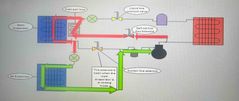
What type of defrost system is this? |
3 pipe conventional flow with re-evaporator hot gas defrost system |
|
|
What does the dial on a constant cut in thermostat control? Cut in or cut out? |
The cut in is fixed. The cut out is not and can be adjusted to set cooler temperature. |
|
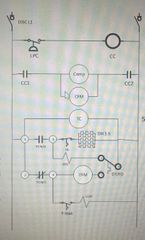
What type of defrost system is this? |
Time initiated-temperature terminated-time backup safety
(1)note the condenser fan in parallel with compressor. With a hot gas 3 pipe conventional flow system they will turn off the condenser fan so it will be in parallel with the t-stat and LLSV rung. |
|
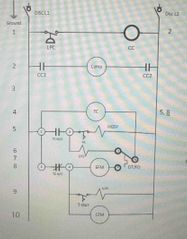
What type of defrost is this diagram depicting? |
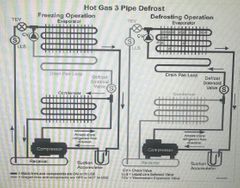
Pump down system with a 3 pipe conventional flow. You only need a HGSV will open and force hot gas into the inlet of the evaporator. |
|
|
When is the hot gas defrost most efficient? at the beginning or end of the defrost cycle? |
The hot gas is most efficient at the beginning because it runs out of heat quickly. |
|
|
What are the pros and cons of 3 pipe system? |
Pros: (1) very fast Cons: (1) thermal shock damage (2)heat dissipates quickly (3)3 pipe systems need 3 pipes so cost more. (4)proper pipe sizing is critical (5)hot gas pipe must be insulated |
|

What type of defrost does this system use? |
3 pipe conventional flow with re-evaporator System has a defrost solenoid valve and a re-evaporator solenoid valve. The re-evaporator allows the hot gas to remain high throughout the defrost. |
|
|
What are the pros and cons of 3 pipe system? |
Pros: (1)fast (2) no liquid returning to the reciever (3) reevap keeps hot gas hot Cons: all of the cons of “3 pipe conventional flow” and more!! Requires an additional suctionline solenoid valve to be open during cooling to avoid excess pressure drop. |
|
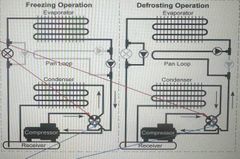
What type of defrost is pictured? |
Reverse cycle defrost Pros: (1)less piping (2)condenser fan stays on TO ABSORB MORE HEAT because it acts as an evaporator during defrost. Cons: (1) thermal shock (2)reversing valve issue (3) may freeze if condensing unit is outside. |
|
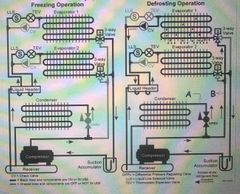
What type of defrost is depicted? |
2 pipe reverse flow |
|
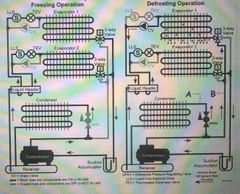
What are the pros and cons of a 2 pipe reverse flow system? |
Pros: (1) fast (2) hot gas condenses and goes into liquid header to be used to cool other evaporators. (3) with 1 evap is in defrost the other evaporators in cooling maintain the availability of hot gas. (4) discharge gas can be used to preheat the hot water. (5)minimal additional piping Cons: (1) thermal shock (2) added complexity. (2.1)Needs a DDRV (aka DPRV, aka DDR) lowering high side condenser pressure and allows hot gas to flow backwards and towards the liquid header. (2.2)Also need need a check valve installed in parallel with the LLS AND TXV. (2.3)Also needs a hot gas solenoid valve to be installed on every evaporator outlet to allow hot gas to enter into the evaporator. |
|
|
Superheat for AC, Fridge, Freezer? |
15, 10, 5 |
|
|
Temperature difference (between evap coil SST and return temp) |
15-20 reach in 8-10F walk in cooler/freezer |

